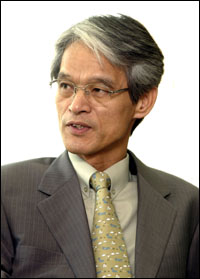 Professor Ho-keun Song, Dept. of Sociology
Professor Ho-keun Song, Dept. of SociologyIt would be ideal if the main result of redeveloping the four rivers is not improving the rivers themselves, but creating ocean networks and establishing port cities.
We are all feeling the burden of the economic crunch, but why don’t we divert our thoughts with a bit of imagination? Let’s suppose that Seoul had a harbor.
In fact, the capital used to be a port. After the first steamboat chugged up the Han River in 1888, merchant ships from Germany, the United States and Qing China made grand appearances.
Ships approached the capital, Hanyang, via the Han River, which formed the core of the water transportation system in the Joseon Dynasty. You could approach Songpajin from mountains in the inland.
Mapo and Seogang were crowded with boats bearing all kinds of fish, salted, fresh and dried. Ttukseom, Gwang Ferry and Seobinggo Ferry were busy with small, wooden ships that carried lumber, coal, vegetables and livestock.
A century ago, sizable steamboats with Korean names such as the Yongsan, the Jegang and the Sunmyeong navigated the Han. Small and large traders opened shops at each ferry point, selling all kinds of goods, Park Eun-suk wrote in her book, “History of Market.” By all means, Seoul was a port city.
Seoul became an inland city for two reasons. In 1900, the Seoul-Incheon Railway was completed, opening the era of the train. And in 1953, the truce ending the Korean War defined the military demarcation line in a place where it overlapped with the mouth of the Han River.
While the railway brought the decline of boats, it did not completely close off Seoul from the sea. The demarcation line took care of that. If it had been drawn a little to the north instead, marine culture would still be a part of the city.
Legendary songstress Lee Nan-yeong would have sung “Seoul is a port” instead of her famous “Mokpo is a port.” The lyrics would have been, “A whistle blows in the fog at Yanghwajin, and sea gulls cry near the lighthouse on Bam Island. I miss my hometown, the port city of Seoul.” The sentimental song would have been treasured by people drinking at bars, and passenger ships would have sailed along the river blowing romantic whistles.
It is a pity that Seoul lost its link to the sea. The ocean represents an unknown world to humanity. The mystery beyond the horizon has inspired countless explorers to set sail on a voyage. Foreign ships and strangers awakened their imaginations with visions of people living in other lands. Harbors are channels where the ocean flows in and inland deficiencies are exposed to the outside.
Cities with the greatest historical influence were mostly harbors, from Amsterdam to London to Boston to New York to Los Angeles. The ocean has always been the great demagogue, urging cities around the world to compete.
It does not confine thoughts and concepts. Instead, it opens the way to communication. Once Seoul lost its function as a port, Koreans lost the essence of ocean culture ? connection, flexibility, mobility and progress.
Hopefully, the Green New Deal’s redevelopment of four major rivers will stimulate the economy in landlocked regions and bring new life to the nation’s cities. The government plans to invest 830 billion won ($635 million) in Chungju, Daegu, Andong, Gongju, Naju and Hampyeong, with 14 trillion won expected to be added next year.
The program will effectively pull us through the financial crisis, but a more important impact will be changes to cities. They will go from being closed inland pockets to thriving ports. Their cultural evolution will go far beyond the immediate financial impact, estimated to be about 23 trillion won. The connection to the ocean culture has more than monetary value.
Recently, China and Taiwan opened a two-way sea lane after 59 years of division over the Taiwan Strait. Sixty-three ports in mainland China and 11 ports in Taiwan will form a tight network, which will create a comprehensive marine trade system in East Asia when ports in western Japan join. Korean cities need to take a part in this network as well.
Ports on Korea’s southern and western coasts such as Incheon, Gunsan, Mokpo, Yeosu and Busan will definitely join the network, but inland cities should contribute to a multicultural system that encompasses sea and overland routes. In order to play such a role, these cities must also become ports. Shanghai, Hong Kong, Tokyo and Osaka already have harbors. Seoul fell behind Shanghai and Tokyo after it lost access to the sea.
So, it would be ideal if the main objective for redeveloping the four rivers shifts from improving the rivers themselves to creating ocean networks and establishing port cities. That would be a cultural project showing imagination and progress.
If we successfully reconnect the ocean with Seoul, the next generation will proudly call Seoul a port.
December 28, 2008

